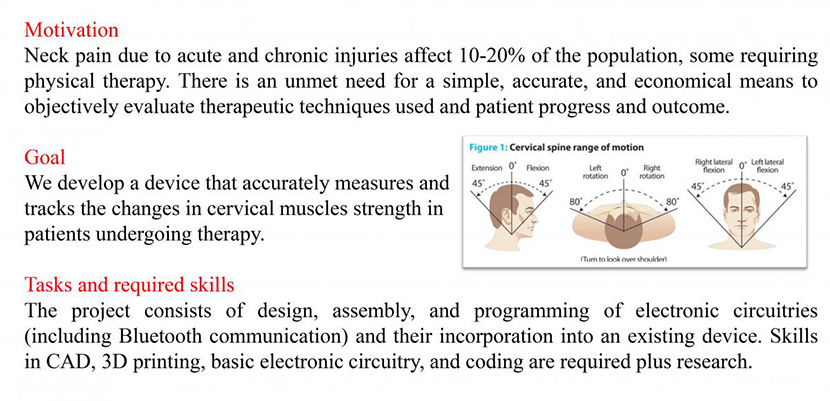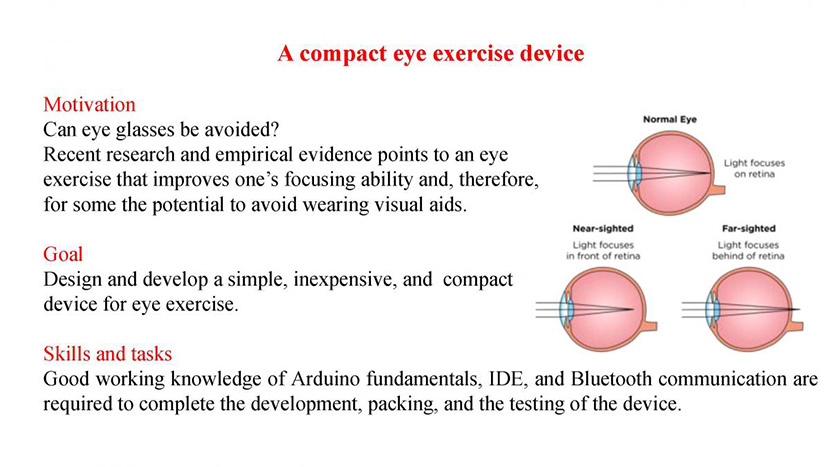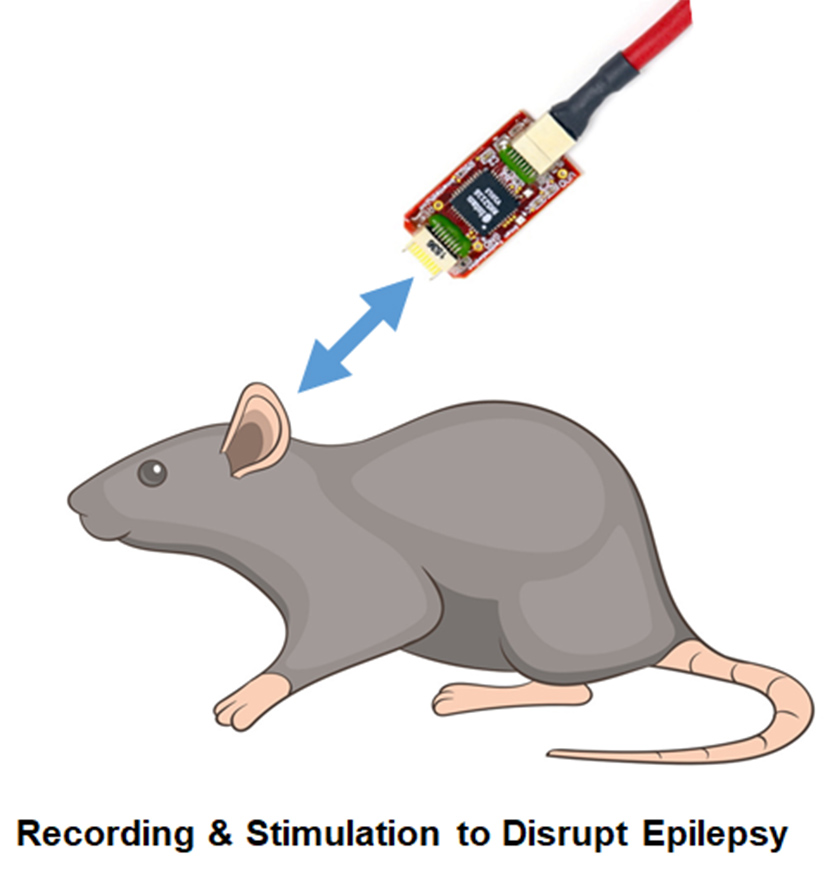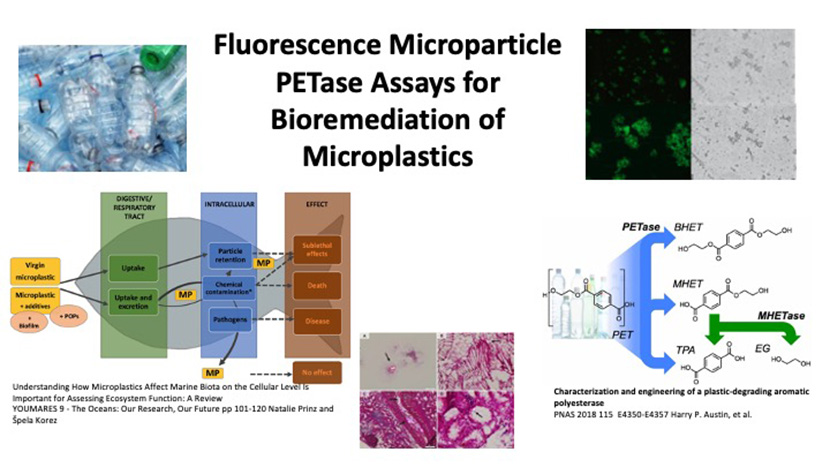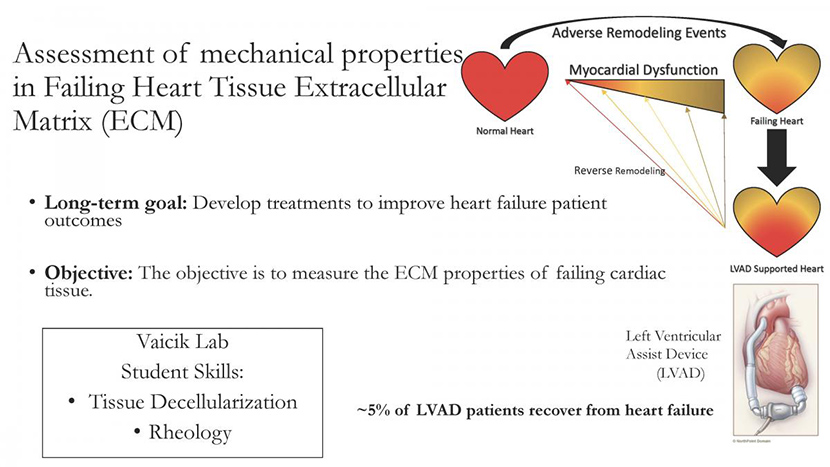Matched! A novel cervical diagnosis and rehabilitation device
Professor: Ali Khounsary (amk@iit.edu)
Department: Physics
Matched Student: Gabriel Beutel
Brief Description: In this project, we develop a device that measures the strength of cervical muscle groups vs. pitch (flexion/extension), yaw (right and left rotations), and roll (right/left lateral flexion) angles.
The new device is an advancement over existing devices which measure only the strength with the head in upright position. However, this strength depends on the angle at which one’s head is held. Measuring the variations of muscle strength / weakness vs the said angles provide significant diagnostic and therapeutic benefits currently untapped.This device can be developed and prototyped inexpensively in one semester. There is potential for patent and commercialization.
The tasks involve reviewing background information, ordering parts, assembling the electronic parts, writes the necessary codes, and then test the device. Background in electronics, coding, and 3D printing are required.
Matched! A Compact Eye Exercise Device
Professor: Ali Khounsary (amk@iit.edu)
Department: Physics
Matched Student: Shelby Kroeger
Brief Description: Many ideas have been proposed and promoted over the years to improve the eye’s ability to focus (to cure the so-called convergence insufficiency). Based on recently published large-scale randomized clinical trials, only one of the ideas is effective. In this project, we prototype an electro-optical, easy-to-use, device that operates based on an empirically shown eye exercise protocol. This pocket size device could be patented and commercialized. The expected cost per unit is under $50. Another possible application of this device (which we intend to pursue after a prototype is built) is for its possible use by astronauts to combat the well-documented structural changes in the eye (flattening of the back of the eyeball) which occurs during prolong space travels and stays. The project starts by reviewing some background information provided by the faculty including some existing ideas, obtain the necessary electronic parts, assemble, program, and test. A solid background in electronics and coding is required; familiarity with CAD and 3D printing are helpful.
Matched! Constructing a Mechanically Robust Interface for Conducting Brain Wave Epilepsy Experiments on Freely Moving Rodent Subjects
Professor: David Mogul (mogul@iit.edu)
Department: Biomedical Engineering
Matched Student: Kristen Raffanti
Brief Description: Experiments are being conducted in the Mogul laboratory to learn more about epilepsy and find new ways to apply electrical stimulation to treat this very difficult disease. We perform experiments using epileptic rodent subjects that interface with electronic circuitry that is sophisticated but one that often disconnects during experiments because subjects have freedom of movement. I am looking for someone who can meet the challenges of creating an important and robust mechanical system of multiple parts that will permit these important experiments to continue for many days. Important skills include (but are not limited to): 3-D printing (design & build), facility with mechanical design, good problem-solving abilities.
Matched! A Machine Learning Approach for Understudying Intracellular Motor-Driven Transport
Professor: Jinqiao Duan (duan@iit.edu)
Department: Applied Math
Matched Student: Alex Negron
Brief Description: We will devise a data-driven method to examine the intracellular motor-driven transport. This will be based on recent machine learning advances in our Lab for Stochastic Dynamics & Computation at Illinois Tech. The major task of this project is then to develop a computational code to apply our theoretical methodology to a dataset (either simulated or real dataset). In collaboration with a colleague at Argonne National Laboratory, our team will finish this project and submit a manuscript for publication.
Matched! Pushing Highest Frame Rate Cine MRI Beyond the State-of-Art
Professor: Keigo Kawaji (kkawaji@iit.edu)
Department: Biomedical Engineering
Matched Student: Marissa Redington
Brief Description: Compressed Sensing (CS), is a potentially powerful technique that uses computing power and nonuniform data structure to iteratively (i.e. gradually) enhance signal, while reducing noise. This project examines the mathematics of one such application for the theoretically highest possible frame-rate Cardiac Cinematic MRI that we recently developed here in Chicago, and inspired multiple student projects in subject domains of image reconstruction, image denoising, and application of Deep Learning or Deep Neural Networks for accelerated imaging.
The goal of this RES-MATCH project is to offer the matched student to gain initial exposure to computational image reconstruction research, for which the student will follow a previous curriculum provided through the Undergraduate Engineering Summer Immersion course EGR 499 in 2019. The matched student will gain specific experience in such research methods while receiving mentorship from BME upperclassmen project members, and will receive hands-on training into the ideation and delivery of new and original, inter-related algorithmic techniques.
The selected RES-MATCH student will work with a diverse research team that includes: IIT-BME faculty/graduate and other undergraduate students assigned to this and similar projects (regular team meetings), MD physician researchers at the University of Chicago Medical Center (clinical immersion), and international collaborators (e.g. in Japan, Canada, and UK/Portugal).
Matched! Translation of Novel Machine Learning Techniques Revisited with Framework Safeguards
Professor: Keigo Kawaji (kkawaji@iit.edu)
Department: Biomedical Engineering
Matched Student: Khiem Nguyen
Brief Description: The recent dramatic increase in computing power, cloud-based data management, and Artificial Intelligence (AI) have led to the emergence of new computational methods. Commonly known as Machine Learning (ML), these methods learn from a large volume of existing datasets to teach itself elaborate computing tasks without the explicit need for conventional algorithmic programming. While such ML methods are promising and thus are rapidly proliferating into clinical settings, these techniques also have pitfalls - including their lack of transparency (i.e. black-box design) and in their inability to differentiate inherent errors embedded into the training datasets. Hence, physicians who may use these ML methods are rightfully skeptical about their notable mathematical and statistical formulations (e.g. if an image filtering AI trained on hearts sees a brain, could such AI erroneously synthesize image characteristics specific to hearts into the brain filtering step?)
The goal of this RES-MATCH project is to offer the matched student to learn the beginnings of such AI algorithm development and computation techniques using existing Biomedical Datasets in cardiac and neurovascular imaging (MRI), and also in diabetes (CGM). The matched student will additionally gain complementary training in the clinical translation process of an AI cascade system that: a) can better mimic the physician thinking process over existing AI-based single tasks, and b) potentially mitigate erroneous AI-driven decisions from affecting eventual clinical decision-making.
The selected RES-MATCH student will work with a diverse research team that includes: IIT-BME faculty/graduate and other undergraduate students assigned to this and similar projects (regular team meetings), MD physician researchers at the University of Chicago Medical Center (clinical immersion). When choice opportunity may arise, the student may potentially interact with international collaborators (e.g. in Japan, Canada, and UK/Portugal).
Matched! Neural Networks Reverse-Engineered to Provide Efficient Large Volume Dataset Labeling
Professor: Keigo Kawaji (kkawaji@iit.edu)
Department: Biomedical Engineering
Matched Student: Stephanie Brink
Brief Description: Machine Learning (ML) and Deep Neural Network (DNN) algorithms leverage on a data training step and a large volume of human-prepared datasets. Elaborate computing tasks are typically taught from such labeling. A considerable bottleneck currently exists in potentially laborious and time-consuming preparations – for example in Biomedical settings, these steps necessitate MD physicians to work for months (or even years!!) to provide reliable annotations for AI-based algorithm development.
Several current BME students have ideated clever approaches to potentially overcome these laborious processes to facilitate rapid and reliable labeled dataset preparations. Inspired by proof-based techniques such as strong mathematical induction, combinatorics-based optimization, and the pigeonhole principle (which are notably prominent in mathematics Olympiads and collegiate math contest space), we will examine two proof-of-concept approaches to overcome the above bottleneck. For this project, students will learn not only the candidate scientific approaches, but also BME intellectual property (IP) processing steps currently undertaken by the student members.
The selected RES-MATCH student will work with the IIT-BME faculty, one or two BME graduate students, (regular team meetings), and one MD physician stakeholder at the University of Chicago Medical Center (clinical immersion) for this project. The RES-MATCH curriculum will additionally incorporate inter-related programming such as the National Science Foundation sponsored Innovations Corps (I-Corps) at the neighboring Polsky Center of Entrepreneurship (University of Chicago).
Matched! Fluorescence Microparticle PETase Assays for Bioremediation of Microplastics
Professor: Nick Menhart (menhart@iit.edu)
Department: Biology
Matched Student: Sadie Meunier
Brief Description: Poly (terephthalate hydrolase), PETase, and related enzymes are now being actively investigated and developed for possible bioremediation of bio-accessible microplastics, which are an emergent environmental pollution problem, and health hazard. However, research is hampered by the lack of a high sensitivity assay for PETase on a solid substrate. This project involved the development of fluorescently tagged micro and nanoparticle PET for use in the development of fluorescence polarization assays for PETase (and possibly other plastic degrading enzymes). This will involve synthesis and characterization of such fluorescence particles, expression of the relevant enzymes, and assay development and characterization.
Matched! Assessment of Mechanical Properties in Failing Heart Tissue Extracellular Matrix
Professor: Marcella Vaicik (mvaicik@iit.edu)
Department: Biomedical Engineering
Matched Student: Colin Harris
Brief Description: The objective is to measure the ECM properties of failing cardiac tissue. Student will learn 1) tissue decellularization process and 2) rheology sample preparation and analysis.
Matched! Persistent Luminescence Nanoparticles for Autofluorescence-Free Biosensing
Professor: Yuanbing Mao (ymao17@iit.edu)
Department: Chemistry
Matched Student: Kunj Patel
Brief Description: Persistent luminescence nanoparticles (PerLNPs) can remain luminescent after cessation of excitation. They have emerged as important materials in biomedicine due to their special ability to eliminate tissue autofluorescence. In this study, we plan to synthesize metal oxide nanoparticles as bioprobes. Specifically, we propose to apply these bioprobes to determine the concentrations of lysozyme by serum lysozyme analysis of samples from patients with lung cancer, gastric cancer, and colorectal cancer. Since the bioprobes display long persistent luminescence, serum autofluorescence interference can be completely eliminated. It is expected that the developed PerLNPs possess tunable size and desirable persistent luminescence as ideal probes for eliminating autofluorescence interference in biosensing. This work is valuable in research areas such as studying the functions of biomolecules and monitoring of molecular/cellular networks in their native contexts.
Matched! Water-Soluble Dual-Emitting Nanocrystals for Ratiometric Optical Thermometry
Professor: Yuanbing Mao (ymao17@iit.edu)
Department: Chemistry
Matched Student: Aaron Gregory
Brief Description: Temperature is one of the most fundamental observables in many areas of modern science and technology, e.g. it plays critical roles in many biological and biotechnological processes ranging from calcium signaling and protein folding to polymerase chain reaction and thermotherapy. However, due to insufficient contact area between the thermometer and the object/area to be measured, the precise and noninvasive measurement of local temperature with high spatial resolution at the micro- and nanoscale is still very challenging for conventional thermometers. In this study, we propose to develop water-soluble dual-emitting metal oxide nanocrystals as a new type of thermometers with the capability of precise temperature measurement at the micro- and nanoscale, which could provide a powerful new tool in various areas of application such as nanomedicine, microfluidics, and photonics.
Matched! Self-Sustained Vaccine Storage Solution With Thermoelectric Devices
Professor: Heng Wang (heng.wang@iit.edu)
Department: Mechanical, Materials, and Aerospace Engineering
Matched Student: Muhammad Taha Navaid
Brief Description: In order to keep their potency, vaccines need to be stored under fairly strict conditions: the temperature needs to be kept at around 5 °C (±2-3 °C). For remote villages in under-developed parts of the world, this creates a big obstacle to bring vaccines to those populations who need them the most. During the transportation and before the vaccines are used, cold chains, even electricity is often not available. Standard portable equipment would push the cost inhibitively high for local health system with little resource.
Thermoelectric devices can be used for cooling, which is more cost effective and efficient than regular compressor based systems for this application. We could thus offer a solution with insulated boxes cooled by thermoelectric devices, which are powered by solar cells. The challenge is how to tailor a device, from its building materials, that is capable for this job with minimum cost.
In this research, we will first determine what is the minimum requirement on the thermoelectric device for such application, next we will assemble a prototype box with commercially available components to optimize the system design. Finally, we will identify the best thermoelectric device design and ultimately realizing it.


